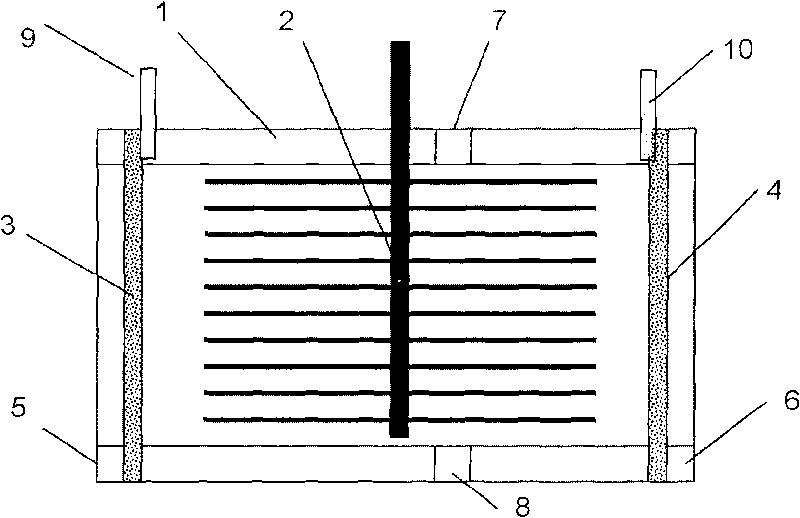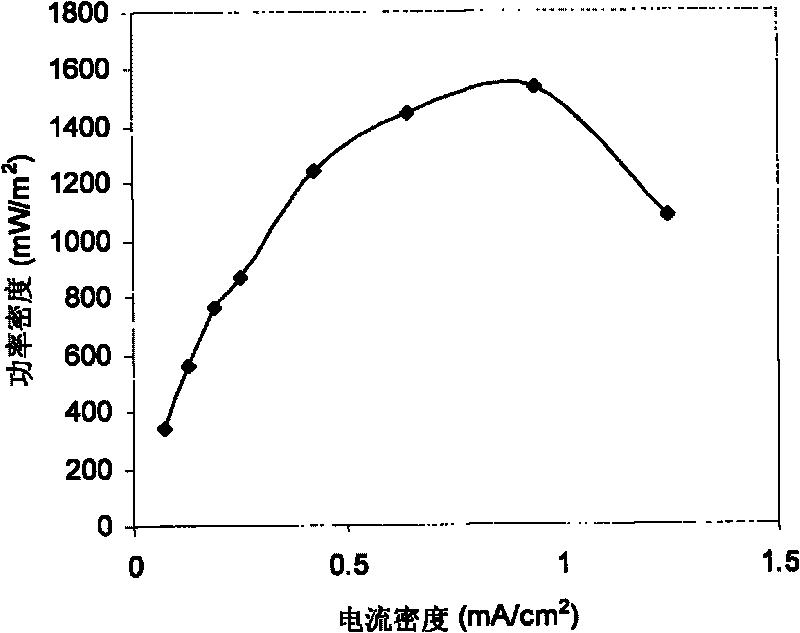Single-chamber microbial fuel cell without metal catalyst
A fuel cell and catalyst technology, applied in biochemical fuel cells, battery electrodes, biological water/sewage treatment, etc., can solve the problems of expensive metal platinum, complicated operation process, complicated preparation process, etc., and achieve high oxygen reduction characteristics, And the effect of stable oxygen reduction characteristics and simple activation process
- Summary
- Abstract
- Description
- Claims
- Application Information
AI Technical Summary
Problems solved by technology
Method used
Image
Examples
specific Embodiment 1
[0037] see figure 1 In this embodiment, the microbial fuel cell is composed of a battery housing 1, an anode 2, a cathode 3,4, a cathode fixing plate 5,6, a water outlet 7, a water inlet 8, and a cathode wire (titanium wire) 9,10. The anode 2 is a carbon fiber brush with a titanium core, which is placed in the center of the side of the battery case. The carbon fiber brush with titanium core is made of several groups of activated carbon fibers intertwined with the titanium wire in the center. Its shape is similar to a test tube brush, so it is called a carbon fiber brush with titanium core (see figure 1 ). Two cathodes 3, 4 are placed at both ends of the battery case 1 and fixed with cathode fixing plates 5, 6. The catalytic layer of the cathode 3 and 4 faces the solution, and the diffusion layer faces the air. The cathode wires 9, 10 and the anode 2 are connected to an external circuit. The battery can operate in two modes of gap and continuous flow. When running in gap mo...
specific Embodiment 2
[0040] Compared with the specific embodiment 1, this embodiment is the same as the specific embodiment 1 in terms of structure, connection and operation except that only one cathode is installed on one side of the battery casing and the other side is sealed. When the battery is started, change the load resistance to measure the power curve of the battery (see image 3 ). The maximum output power of the battery is 1540mW / m 2 .
specific Embodiment 3
[0041] The difference between this embodiment and the specific embodiment 2 is: when the battery is started, the electrolyte is completely replaced with actual domestic sewage for operation. Other structures and connections are the same as in Example 2. The result of the operation is as follows Figure 4 shown.
PUM
 Login to View More
Login to View More Abstract
Description
Claims
Application Information
 Login to View More
Login to View More - R&D
- Intellectual Property
- Life Sciences
- Materials
- Tech Scout
- Unparalleled Data Quality
- Higher Quality Content
- 60% Fewer Hallucinations
Browse by: Latest US Patents, China's latest patents, Technical Efficacy Thesaurus, Application Domain, Technology Topic, Popular Technical Reports.
© 2025 PatSnap. All rights reserved.Legal|Privacy policy|Modern Slavery Act Transparency Statement|Sitemap|About US| Contact US: help@patsnap.com



